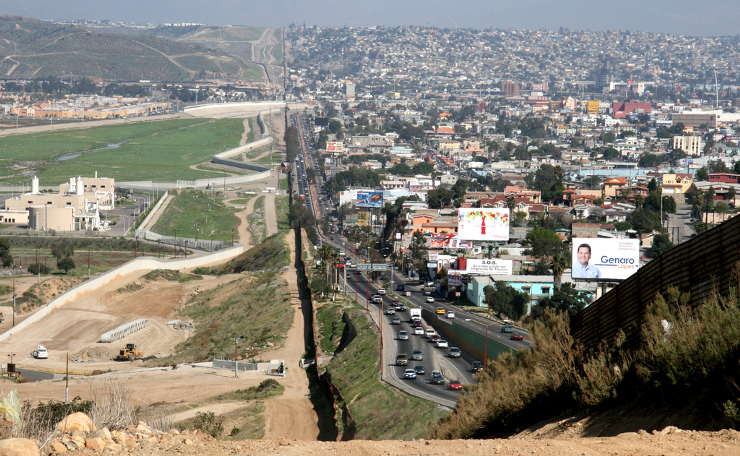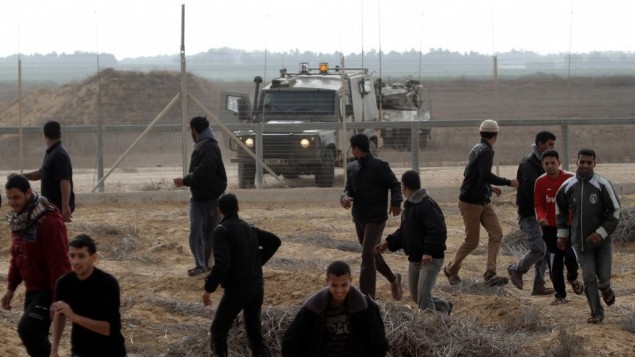There is one similarity between the Israel/Gaza crisis and the U.S. unaccompanied child immigrant crisis: National borders enforcing social inequality. When unequal populations are separated, the disparity creates social pressure at the border. The stronger the pressure, the greater the military force needed to maintain the separation.
To get a conservative estimate of the pressure at the Israel/Gaza border, I compared some numbers for Israel versus Gaza and the West Bank combined, from the World Bank (here’s a recent rundown of living conditions in Gaza specifically). I call that conservative because things are worse in Gaza than in the West Bank.
Then, just as demographic wishful thinking, I calculated what the single-state solution would look like on the day you opened the borders between Israel, the West Bank, and Gaza. I added country percentiles showing how each state ranks on the world scale (click to enlarge).
Israel’s per capita income is 6.2-times greater, its life expectancy is 6 years longer, its fertility rate is a quarter lower, and its age structure is reversed. Together, the Palestinian territories have a little more than half the Israeli population (living on less than 30% of the land). That means that combining them all into one country would move both populations’ averages a lot. For example, the new country would be substantially poorer (29% poorer) and younger than Israel, while increasing the national income of Palestinians by 444%. Israelis would fall from the 17th percentile worldwide in income, and the Palestinians would rise from the 69th, to meet at the 25th percentile.
Clearly, the separation keeps poor people away from rich people. Whether it increases or decreases conflict is a matter of debate.
Meanwhile
Meanwhile, the USA has its own enforced exclusion of poor people.

The current crisis at the southern border of the USA mostly involves children from Guatemala, Honduras, and El Salvador. They don’t actually share a border with the USA, of course, but their region does, and crossing into Mexico seems pretty easy, so it’s the same idea.
To make a parallel comparison to Israel and the West Bank/Gaza, I just used Guatemala, which is larger by population than Honduras and El Salvador combined, and also closest to the USA. The economic gap between the USA and Guatemala is even larger than the Israeli/Palestinian gap. However, because the USA is 21-times larger than Guatemala by population, we could easily absorb the entire Guatemalan population without much damaging our national averages. Per capita income in the USA, for example, would fall only 4%, while rising more than 7-times for Guatemala (click to enlarge):
This simplistic analysis yields a straightforward hypothesis: violence and military force at national borders rises as the income disparity across the border increases. Maybe someone has already tested that.
The demographic solution is obvious: open the borders, release the pressure, and devote resources to improving quality of life and social harmony instead of enforcing inequality. You’re welcome!




You make perhaps a false equivalence where you imagine that well-funded Islamists freely going into Israel would be the equivalent of destitute South American children coming into the United States.
LikeLike
You make perhaps a false equivalence where you imagine that Palestinias would equal well-funded Islamists.
LikeLike
“open the borders, release the pressure, and devote resources to improving quality of life and social harmony instead of enforcing inequality. You’re welcome”
what? why should the population pressure released into San Diego?
In Gaza+West Bank, the population was 1 million in 1970, and 4 million in 2010. This is due to TFR being above 5 and up to 8. Why should srael bear the release of this?
LikeLike
Reblogged this on The Life Of Von and commented:
Some figures….
LikeLike
“This simplistic analysis yields a straightforward hypothesis: violence and military force at national borders rises as the income disparity across the border increases.”
Other possible statements:
1) “This simplistic analysis yields a straightforward hypothesis: income disparity across the border increases.as violence and military force at national borders rise”,
2) “This simplistic analysis does admittedly omit a few other factors when it simply throws economic numbers into a blender and comes up with a solution: Hatred. Religious fundamentalism. (cf murdered Jewish and Palestinian teenagers). The fact that, literally, millions of Jews were driven to move to Palestine by early 20th century pogroms in Eastern Europe, the murder of many millions of Jews in Western Europe, the persecution of Jews in Russia; most of these Jews having neither the leisure or education to wonder who was living in this place they were running to. The fact that the Palestinians didn’t ask these people to come and, so, many hated their presence long before there was a state of Israel; and many more hate their presence now that the overwhelming power of the Israeli state has put them under occupation.”
3) In this cauldron it’s hard to find non-simplistic analyses. My own simplistic analysis is that the impossible dream of two states living side by side, in peace and and prosperity and mutual tolerance, with international governance of the Old City of Jerusalem is still more probable than a single-state solution.
LikeLike
Thank you.
I agree with your first two points. But that history you gave stops before two big inflammatory developments: Among Israelis, the influx of religiously-motivated American Zionists who have no reason to be there except zeal; and among Palestinians, the displacement of secular nationalism by Islamic extremism.
Your third point, I don’t know. Hard to say which impossible dream is more probable. One insurmountable problem with the two-state solution is that modern states can’t really have ethno-religiously defined citizenship, so I don’t see how that works. One insurmountable problem with the one-state solution is that so many of them hate each other.
LikeLike
It never ceases to surprise me that on issue of emigration, rich conservatives and left-wingers speak exactly the same. Probably because modern left-wingers belong mostly to the middle class, and middle class is gaining from the emmigration – the cost is paid by the poorest, most vulnerable members of society.
Not to mention that open borders policy assumes people are perfectly interexchangeable (and they are not), and state has no obligation to the current citizens above the obligations to the people who are no citizens. Not to mention open borders changes irrevocably the ethnic composition of the state, imports new citizens who usually will vote for left and center parties.
LikeLike
I totally agree with “szopeno” opening borders does pose a political challenge. However this post also points out a really important idea of what South Africa has called “Ubuntu”. Ubuntu is a close concept to social harmony, where people are encouraged to show tolerance and empathy for those around them. Perhaps it is something that resonates throughout African cultures where “umuntu umuntu ngabantu (you are who you are because of other people)”. When there is an economic gap between neighbouring countries, there will be migration in search of a better life. Social harmony can only be created when there is tolerance of all humans and acceptance of them as brothers and sisters. Perhaps South Africa didn’t get this right entirely (refer to : Xenophobic attacks in South Africa) but the idea was always to strive towards peaceful leaving. The thing that countries need to cater for is the over saturation of foreigners in the working class. Granted everyone must get equal opportunity to work and earn a living, but a country should be taken forward by people who understand the history, traditions and political vision of the country.
LikeLike